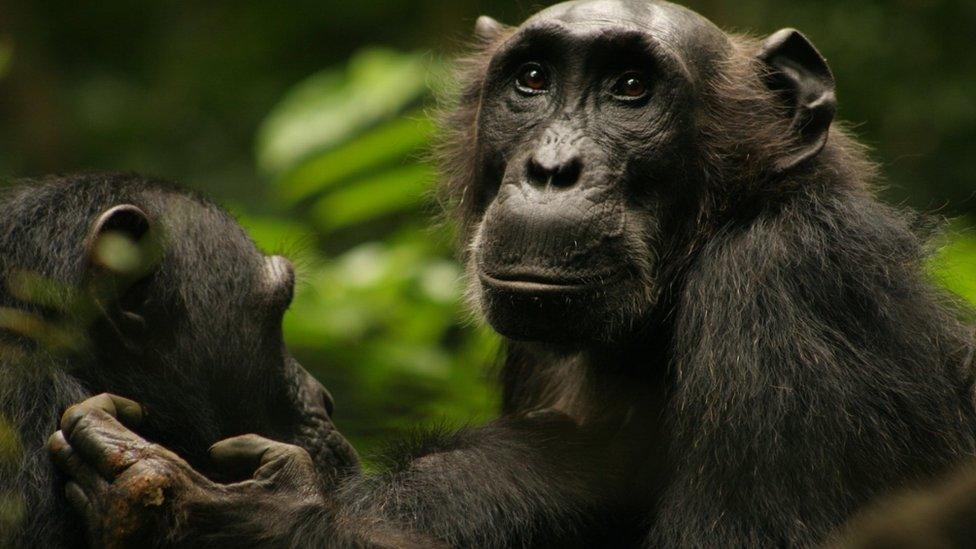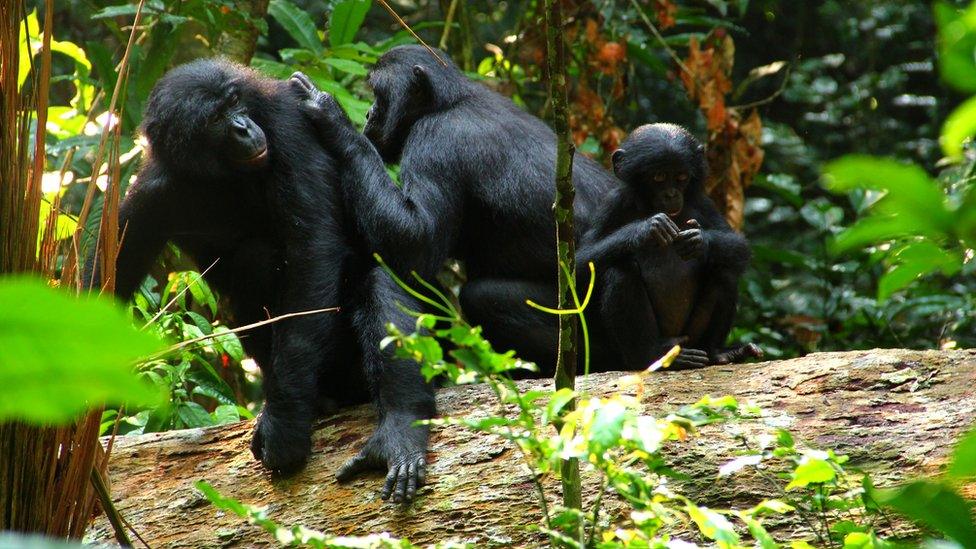Primate speech: How some species are 'wired' for talk
- Published

Bonobos are the non-human primates with the most extensive vocal repertoire
Our primate cousins have surprised and impressed scientists in recent years, with revelations about monkeys' tool-using abilities and chimps' development of complex sign language.
But researchers are still probing the question: why are we humans the only apes that can talk?
That puzzle has now led to an insight into how different non-human primates' brains are "wired" for vocal ability.
A new study has compared different primate species' brains.
It revealed that primates with wider "vocal repertoires" had more of their brain dedicated to controlling their vocal apparatus.
That suggests that our own speaking skills may have evolved as our brains gradually rewired to control that apparatus, rather than purely because we're smarter than non-human apes.
Humans and other primates have very similar vocal anatomy - in terms of their tongues and larynx. That's the physical machinery in the throat which allows us to turn air into sound.
So, as lead researcher Dr Jacob Dunn from Anglia Ruskin University in Cambridge explained, it remains a mystery that only human primates can actually talk.
"That's likely due to differences in the brain," Dr Dunn told BBC News, "but there haven't been comparative studies across species."
So how do our primate brains differ?
That comparison is exactly what Dr Dunn and his colleague Prof Jeroen Smaers set out to do. They ranked 34 different primate species based on their vocal abilities - the number of distinct calls they are known to make in the wild.
They then examined the brain of each species, using information from existing, preserved brains that had been kept for research.
"It turns out there's this signature within the brains of primates that relates directly to their vocal repertoire," said Dr Dunn.

Proboscis monkeys have only four known vocalisations
Bottom of his ranked list of primates was the proboscis monkey, with four known distinct calls. The apes - led by the bonobo - were at the top; bonobos make 38 distinct calls and it has been suggested that their use of vocalisations are a glimpse of the early evolution of language.
These more vocally adept apes, the study revealed, had relatively large areas of the brain known as cortical association areas - essentially brain regions which receive sensory input and decide what to do with it.
"They're a kind of filter to control the decision-making process," explained Dr Dunn.
Also, and perhaps most importantly, bonobos and the other more vocal apes - including chimpanzees - had much larger parts of the brain dedicated to control of the tongue.
This suggests, the researchers say, that while our primate cousins may well be sufficiently smart to develop and understand complex ways of communicating, the voluntary control of their "vocal apparatus" - rather than their intelligence - is the limiting factor.
Why does this matter?
Since we cannot study our extinct human ancestors, scientists all over the world still look to our closest primate cousins to fill the gaps in our knowledge about the evolution of something as complex and crucial to humanity as language.
Understanding how the brain is wired in these different primate species and how that relates to vocal ability, could, suggested Dr Dunn, "go some way to helping us understand how the complex voluntary control over vocal production may have evolved in humans," ultimately leading to our own ability to speak.
But researchers studying the origins of speech and language still have questions.
Prof Zanna Clay from Durham University is currently in Congo continuing her extensive study of bonobos.
She told BBC News that this particular study was interesting, but cautioned that a much more basic understanding of how exactly primates themselves use and understand their vocalisations was needed before conclusions like these could be confirmed.
"We do not even really understand how the primates themselves classify their own vocal repertoires - this needs to come first before correlations are made," she said.
"We [also] know that many primates and other animals can escape the constraints of a relatively fixed vocal system by combining calls together in different ways to create different meanings.
"The extent to which call combinations might map on to [brain anatomy] would be a promising avenue to explore."
- Published23 June 2017

- Published4 August 2015
